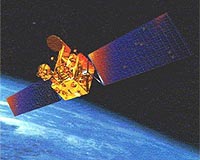 |
Essex, UK (SPX) Jul 03, 2009 e2v has supplied image sensors for the Geostationary Operational Environmental Satellite, GOES-O, which launched on 26 June 2009. GOES-0 is the latest in a series of satellites that monitor Earth and space weather systems, in order to improve predictions regarding hurricanes, flash floods and severe storm warnings, and to help track global climate change. e2v supplied 20 flight model and 20 engineering model CCDs (charge coupled devices) for GOES-N, O and P. Destined for the spacecraft's new Solar x-ray Imager (SXI), designed and built at the Lockheed Martin Space Systems Advanced Technology Center in Palo Alto, California, the imaging devices were supplied in a custom designed package. e2v worked closely with University College London's Mullard Space Science Laboratory (MSSL) and Lockheed on the design, characterisation and supply of the e2v CCDs for this programme. e2v's CCD64 has an image area of 512(h) x 580(v) pixels; each pixel is 16.0 m square. The devices are back-illuminated to an optimised device thickness, in order to ensure the maximum x-ray mean charge capture performance of the devices. SXI utilises a telescope assembly, which monitors the sun's x-ray emissions. This allows solar features, such as solar flares and charged particle clouds to be analysed and fed into space weather forecasts. e2v's performance in support of the SXI programme was recognised by Lockheed, who presented e2v (and MSSL) with a 'superior performance' award. The new CCD package design concept for GOES-N-P has since become a standard that was repeated on the Focal Plane Package for Solar-B and more recently the Solar Dynamics Observatory. Further launches are planned for SXI on future GOES satellites. Jon Kemp, General Manager of Space and Defence Imaging at e2v said "e2v is delighted to have received a 'superior performance' award for delivering world beating image sensors to this important mission and we look forward to continuing to work with Lockheed and MSSL on current and future projects." e2v has over 30 years of experience in the design and manufacture of both standard and highly customised, high performance image sensors and cameras. e2v manufactures CCD, EMCCD, and CMOS area and line scan image sensors for a variety of markets; with technical capabilities including back-illumination, high speed, low noise, high quantum efficiency and sensitivity to photon wavelengths from X-ray through near-IR. e2v routinely provides image sensors for the most demanding applications in space, astronomy and scientific imaging; as well as medical, industrial machine vision, security and professional broadcast and Digital Still Camera (DSC) markets. Share This Article With Planet Earth
Related Links e2v Earth Observation News - Suppiliers, Technology and Application
 India To Launch Indigenous Oceansat-2 Satellite Next Month
India To Launch Indigenous Oceansat-2 Satellite Next MonthNew Delhi, India (XNA) Jul 02, 2009 India will launch its indigenous Oceansat-2 satellite, along with six European nano satellites, next month, the Indian Space Research Organization (ISRO) said Wednesday. "Oceansat-2, weighing around 970 kg, is an in-orbit replacement to Oceansat-1, which has completed 10 years of service. It will carry an Ocean Color Monitor and a Ku-band pencil beam Scatterometer. In addition, it will ... read more |
|
| The content herein, unless otherwise known to be public domain, are Copyright 1995-2009 - SpaceDaily. AFP and UPI Wire Stories are copyright Agence France-Presse and United Press International. ESA Portal Reports are copyright European Space Agency. All NASA sourced material is public domain. Additional copyrights may apply in whole or part to other bona fide parties. Advertising does not imply endorsement,agreement or approval of any opinions, statements or information provided by SpaceDaily on any Web page published or hosted by SpaceDaily. Privacy Statement |